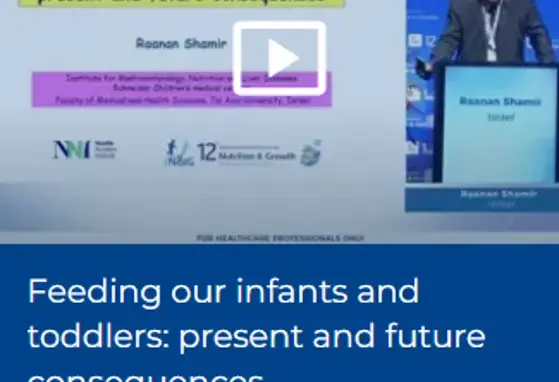Human Milk Oligosaccharides (HMOs) and Paediatric Immunology

It is well documented that the first 1 000 days of a child’s life are the most critical. Improved feeding practices for babies and children, particularly during the first two years, could reduce child mortality rates by almost one fifth. The WHO and UNICEF agree that breastmilk is the key to good nutrition for every child. “Breastfeeding is the best gift a mother, rich or poor, can give her child, as well as herself,” says Shahida Azfar, UNICEF’s Deputy Executive Director.
Breastmilk acts as the baby’s first immunisation, as it is rich in immune-related components like human milk oligosaccharides (HMOs), milk proteins and lipids. While still being gentle on a baby's developing stomach, intestines, and other body systems, breastmilk can be seen as the first functional food humans ever encounter.
Despite being labelled “Nature’s perfect food”, a study in 2013 revealed that over 60% of mothers did not breastfeed to their desired duration. These women terminated breastfeeding for many reasons, exposing the importance of support and education from healthcare professionals and nutrition experts throughout mothers’ breastfeeding challenges to ensure babies are well fed.
 Human Milk
Human Milk
Colonisation of the gut’s immune system begins immediately following birth. Both the formation and interactive development of this early gut microbiota are understood to be (at least partially) driven and modulated by specific compounds that are found in human milk. Human milk consists of fats, proteins, carbohydrates (like lactose and human milk oligosaccharides), and traces of other minerals like calcium, potassium, and sodium. Furthermore, human milk contains many hundreds to thousands of distinct bioactive molecules that protect against infection and inflammation, contributing to immune maturation, organ development, and healthy microbial colonisation.
CMPA
Cow’s milk protein allergy (CMPA) is the most common food allergy in childhood – three in every 100 babies will develop CMPA before their first birthday. CMPA is caused by a baby's immune system reacting to the proteins found in cow's milk. Allergic symptoms include skin irritation (rash, hives or itchy skin), digestive irritation (diarrhoea, vomiting, constipation and reflux) and respiratory irritation (noisy breathing, coughing, runny nose).
Lactose Intolerance
Lactose intolerance, the inability to digest the lactose sugar found in cow’s milk, is a common food allergy in adults . Lactose is one of the most important carbohydrates (sugars) in breast milk and helps to promote healthy gut flora and calcium absorption. CMPA usually develops early in life, whereas lactose intolerance is extremely rare before the age of five.
 HMOs
HMOs
Human milk oligosaccharides (HMOs) are non-digestible carbohydrates making up the third most abundant solid component of human milk after lactose and lipids. In the infant gut, HMOs may act either locally, on cells of the mucosa-associated lymphoid tissues, or at a systemic level, as 1% of HMOs are absorbed and reach the systemic circulation. HMOs serve as prebiotics to promote the growth of beneficial bacteria and antiadhesives to limit colonisation of pathogenic bacteria. HMO have been proven to support the establishment of beneficial gut bacteria and eliminate some pathogens through a decoy effect to strengthen the gut barrier and guide the development of the immune system.
The Functions of HMOs
Dr. Kotha Rakesh, Professor of Neonatology, says there are three main proven functions of HMOs:
Stimulation of Beneficial Microbes: HMOs are difficult to break down, and become a source of food for intestinal bacteria – which are good for the developing gut of the baby.
Protection against Infections: With breast milk comes the consumption of both good and bad microbes. HMOs attach themselves to pathogenic cells, limiting their negative effect on the intestine.
Neurological Development: HMOs help in the neurological development of the baby by providing the brain with sialic acid.
 HMOs and CMPA
HMOs and CMPA
Of the more than 200 HMO structures reported, 2’-FL has particularly unique properties. Although 2’-FL is quantitatively the most abundant HMO in breast milk, only 70-80% of women are genetically capable of producing it. While the protective benefits of HMOs have been investigated for decades, the production of breast milk-identical HMOs (specifically 2’FL and LNnT) has only recently become technically feasible.
Continuous research is being done on the benefits of HMOs and how to supplement formula-fed babies’ diets. Babies with CMPA, who cannot be breastfed, may benefit from the immune-modulating properties of HMO. Professor of Paediatrics, NYU Langone Health, Anna Nowak-Wegrzyn, reports, “HMOs are critical to the support of an infant’s immune system, particularly in those with CMPA as they are more susceptible to infections.”
New data reveals that babies with cow’s milk protein allergy (CMPA) who are fed human milk oligosaccharides have fewer infections, according to Nestlé Health Science’s CINNAMON study.
Across studies, researchers have established that immune markers were significantly lower in infants who were fed HMO-formula compared to control formula. These markers were almost identical to those of breast-fed infants.
Seventy percent of the immune system exists in the gut and the development of a baby’s immune system is closely associated with intestinal microbiota. HMOs play the role of prebiotics, feeding beneficial bacteria. Formerly only found in human milk, scientists and nutritionists are making huge strides in the development of breast milk-identical, 2’FL and LNnT formula.
It is widely agreed that early nutrition is crucial for life-long health. Recognising the multiple breastfeeding benefits for babies, such as receiving HMOs and essential nutrients, it is important that mothers across the globe are educated on such benefits and supported in their breastfeeding efforts.
If you liked this post you may also like




Sunset Series on A Paediatric Update on Brain Development and HMOs
